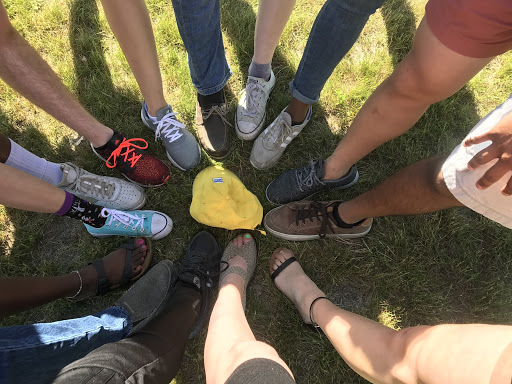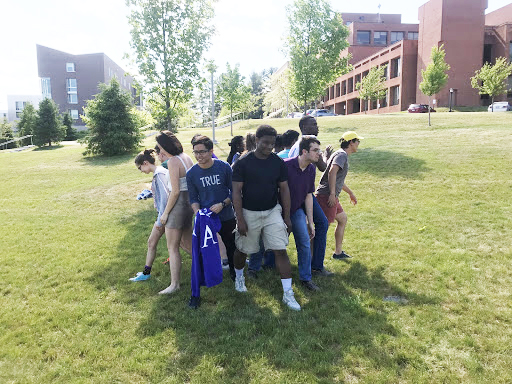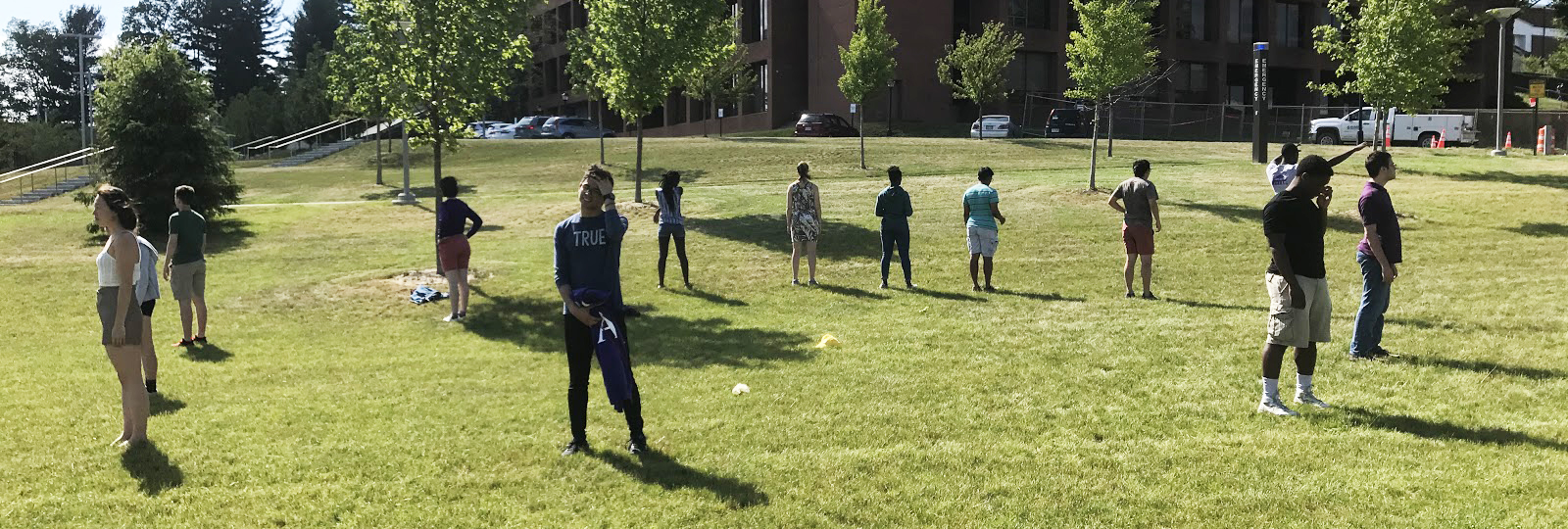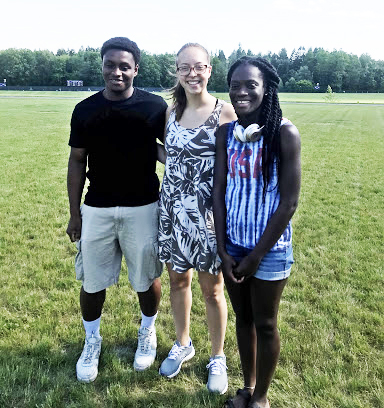Goal: To teach students about random vs. directed motion. Usually motion inside of cells is random. However, small molecule motors inside of cells can move things in a particular direction. Here students will play a game where they will move using both random and directed motion.
Background
Some neurons in your body stretch from your spinal cord to the tip of your toe! While these very long cells have inspired lots of questions, biophysicists wondered how these cells could transport objects over a meter.
Typically, things within the cell that are 1 micron (a millionth of a meter) or less move around due to Brownian motion. Brownian motion is the random movement of objects due to the bombardment of water molecules. Brownian motion was first discovered when scientists looked through microscopes and saw that pollen grains would move up, then right, then up again, then down, and left in a random pattern. Objects within the cell undergo Brownian motion, but the larger objects that we see everyday don’t because the bombardment of water molecules is too small. So, objects in the cell are always moving, but they may be moving in the wrong direction! The question biophysicists wanted to answer was how did the cell transport things in a particular direction.
Of course, scientists knew that the cell uses a very interesting molecule to transport objects, called a molecular motor. This molecular motor uses chemical energy to do mechanical work just like a real motor! The particular molecular motor in the neuron that transports objects is called kinesin. Biophysicists wanted to know everything about kinesin that you might want to know about a real motor--how much force could it produce, what did it use for fuel, how far did it move objects, and did it use a cycle of steps like a real motor would? In 1993, the Block Lab published a landmark paper in Nature that showed that biological motors were cyclic just like real motors and moved in steps. This was followed up by another paper in 1997 by the Yanagida Lab that was published in Biophysical Journal. So, it turns out that the cell uses motors to cart cargo around just like we do!
Here we want to model Brownian motion and the directed movement of a molecular motor. To do this we are going to use a large group to play a game called the “random walk game”.
Parts List
- Group of people
- Coin
- Flag (or something to mark a location, like a balloon, ball, whistle)
How to and What it should look like
First, we will discuss the basic play of the game, and then give specific how-to directions. To play the random walk game, one person will be the “caller” and will stand off to the side, while the rest of group stands in a circle around a flag. The group around the flag then takes 4 giant steps from the flag, spreading out into a circle with their backs to the flag. At this point, the caller will call out forward or backward at random, which will cause the people in the group to move randomly since some people have been given directions to follow the caller and some have been given directions to do the opposite. The play continues as the player moves randomly either closer or further from the flag. Then, when one person gets the flag everyone turns into a molecular motor and can move wherever they would like for five seconds. During this 5 seconds, the person with the flag and the caller try to tag as many people as possible. Once the 5 second is over all the tagged people join the caller and play begins again with the rest of the players starting in a circle around the flag. The last 1-3 people left win!
-
Each person takes a direction--first person does what the caller says, second person does the opposite, third person does what the caller says on odd numbered rounds and the opposite on even numbered rounds, fourth person does the opposite on odd numbered rounds and what the caller says on even numbered rounds, the fifth person does what the caller says every third round and the opposite the rest of the time, the sixth person does the opposite every third round and what the caller says the rest of the time, etc. Once everyone takes a direction, you keep the direction the whole day, through multiple games.
-
Almost everyone will start in the “group” which stands in one huddle around a flag or hat. One person called the “caller” stands off to the side.

-
Then everyone in the group stands with their back facing the flag and takes 4 large steps outward forming a giant circle.

-
The caller then calls out “Round 1” and either “forward” or “backward”. The students are “random walkers” and can move forward or backward according to what the caller says and the direction they were given. Forward is away from the flag in the direction they are facing, and backward is toward the flag that is behind them.
-
Caller then calls out “Round 2” and either “forward” or “backward”. The students move.
-
Caller then calls out Round 3, Round 4, etc. with each time the students moving randomly.



-
Eventually (about round 10 or so) someone will end up back at the flag. At this point, the person grabs the flag. Now everyone is turned from a “random walker” into a “molecular motor” and can move how they please for 5 seconds.
-
During this 5 seconds the caller and the person with the flag try to tag as many people as they can. At first, the other players may not be aware that someone has gotten the flag since they have to face the opposite direction and will be surprised to hear the commotion or be tagged. The initial surprise is part of the fun. Then, the chase will ensue with players getting tagged or not.
-
After the five seconds, the person with the flag and the people that were tagged join the caller and are all the new callers. The flag is placed back in the middle. Everyone else that wasn’t tagged stands next to the flag. Steps #2-#8 repeat again and again, which increases the number of people that are tagged (callers) and decreases the number of people that haven’t been tagged. If things aren’t moving quickly enough, have students in #3 take only 3 big steps from the flag or 2 big steps from the flag. When there are 1-3 people left in the group, these people are crowned the winners.

-
Once the winners have been crowned, play can start again by selecting a new caller who stands off to the side. Everyone else joins the group in the center huddle around the flag. The directions for moving as a random walker that were given at the beginning still apply, streamlining the game.
Players should get a feel for how random motion works. They should realize that random motion isn’t as efficient as directed motion, that is, the random walker isn’t as efficient as the molecular motor. They should also realize that it takes a lot longer to get back to the flag depending on the number of steps that you take away from the flag. You could challenge them to see what happens if they start 10 big steps away. Do they make it back?
Extras
In this game, players are undergoing a random walk. However, even though this walk is random, it can still be described with math. The first thing that you might notice is that the displacement of an individual in the group, x, is on average equal to zero. Some people will move forward and others will move backward, but on average the group will have equal numbers of people forward and backward. We say that:
xavg=0.
The second thing that you might notice is that most people are not where they started from when the game ends. They have moved somewhere! To quantify movement and not worry about whether it is forward or backward, we will square the displacement, then take the mean, then take the square root. This is called the root mean squared displacement, √x2avg, or xrms. The rms displacement is a great value because it lets us talk about the absolute value of the motion. The rms displacement will depend on the number of rounds, N, that you play the game. The more rounds you play, the larger the rms displacement will be. Assuming everyone is just taking 1 step per round, the equation for the rms displacement is:
xrms=√N.
So, the rms displacement will increase quickly at first, but then will start to level off, with more and more rounds not producing as much movement.
You can model this equation with your group. You could start everyone on a line and call out movements. After a particular number of rounds, you could record where everyone is and take the rms. For example, for 4 rounds you might record positions of (1, 0, -3, -1, 1, 2) where positive is forward and negative is backward. If you square you get (1, 0, 9, 1, 1, 4). The mean of these values is 2.6. The root of that is 1.6, which is close to the predicted value of 2.
Of course, we don’t know everything there is to know about molecular motors. How do these molecular motors convert chemical energy into work, how do molecular motors work in groups, and how can we engineer our own synthetic molecular motors? We need future biophysicists to answer these questions.